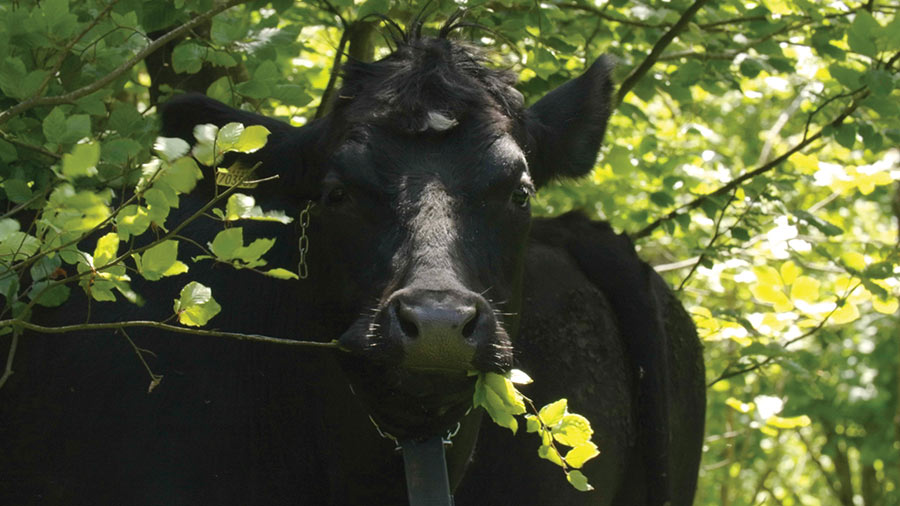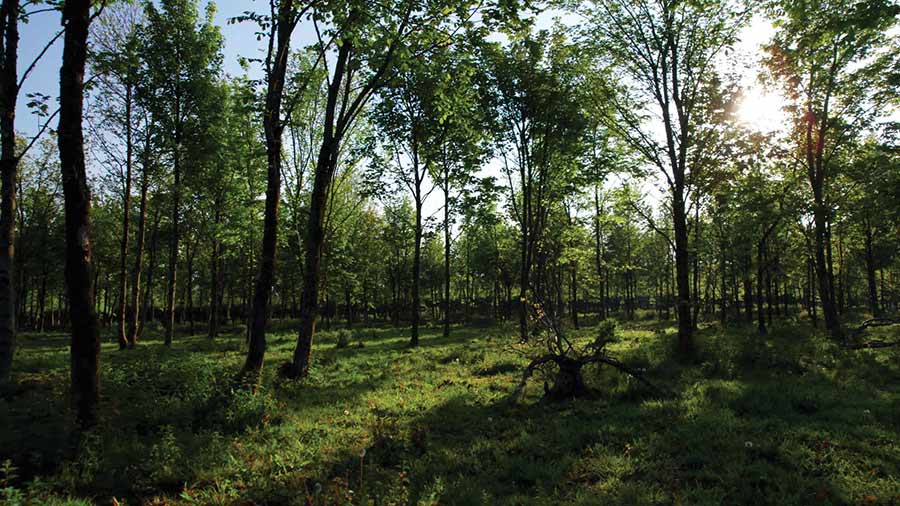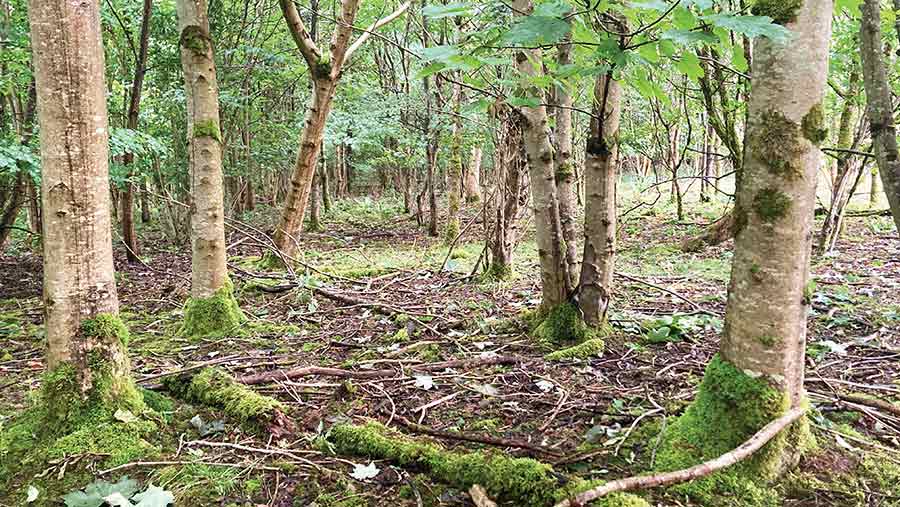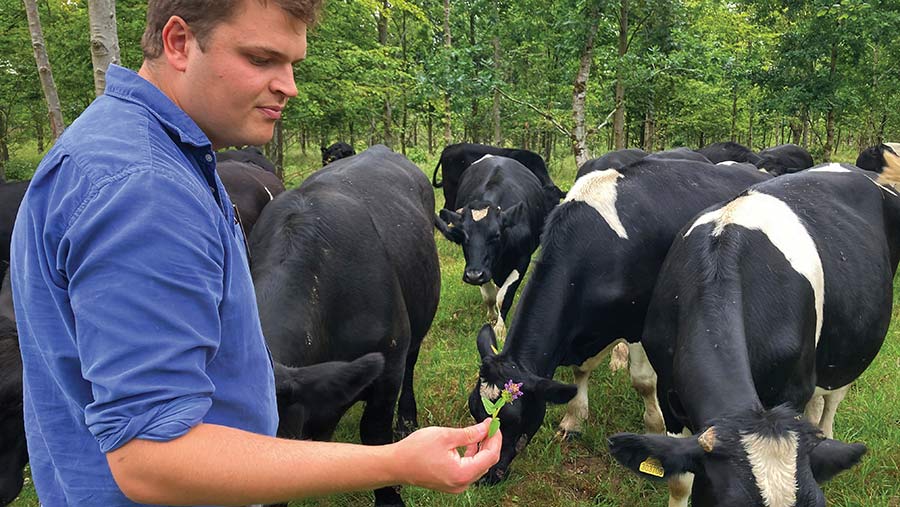450ha woodland core to low-cost dairy-beef system
 © MAG/Michael Priestley
© MAG/Michael Priestley Agroforestry has gone from a novel idea to a core part of a resilient farming model at Yeo Valley in Somerset, with 405ha (1,000 acres) of woodland grazing targeted by 2028.
British Friesian and Angus-cross cattle can finish through the summer on mixed species swards among the shelter and shade of deciduous native trees, explains Will Mayor of Yeo Valley Farms, Blagdon.
Previously, the farm sold most of its beef calves at 14-21 days privately to a calf rearer.
See also: Video: New entrants harness hills with £106 a cow winter feed cost
About 60 were finished annually at home on grass in the summer and high-quality red clover silage, arable silage, and organic cereal in winter.
The experience with woodland has convinced the team to increase the number of cattle finished on farm, says Will.

Grass species quickly establish once more light reaches the woodland floor © MAG/Michael Priestley
The system should lower costs by using less silage and bought-in feed, and the woodland grazing can also be used to outwinter cattle.
“We compared the margin left by 10 animals finished in the woods with 10 finished in a shed on silage and cereal,” he says. “It showed grass finishing is the way to go.”
The aim is to take all beef calves and surplus females from Yeo Valley’s two British Friesian herds: 225 cows at Holt Farm, Blagdon, and 80 cows five miles away at Yoxter Farm, on the edge of the Mendips.
Both herds have been cut back slightly (there were previously 240 at Holt Farm and 180 at Yoxter) as part of a drive to be 100% self-sufficient with feed.
Farm facts: Yeo Valley Farms
- 809ha (2,000 acres)
- 263ha (650 acres) of woodland pasture
- 250 dairy beef cattle
- 305 British Friesian cows, split across two herds
- 22% replacement rate
Getting started

An example of woodland before thinning has taken place, with limited light for grass growth © MAG/Michael Priestley
The idea to harness agroforestry to finish cattle came about when 182ha (450 acres) of woodland between Yeo Valley’s two dairy units came on the market.
The woods, on top of the Mendips, had been established on a former dairy farm in 2001, with some of the paddocks planted almost entirely with ash.
In recent years, ash dieback had killed many trees. Yeo Valley Farms bought the ground in 2018.
Professional foresters were brought in to thin the woods in 2020, removing ash and any wonky trees to let more light reach the forest floor.
Grass naturally came in after a few weeks and cattle were moved into the woods in the spring of 2021.
To simplify management, virtual fencing technology was used to achieve daily rotations, and water was supplied with a bowser.
“The grazing collars worked well, but the economics between fencing and collars with increasing stock numbers – we’re aiming for 500 – made it less viable.”
After an initial graze, herbal leys (see table, right) were broadcast onto the forest floor, using a small Kubota tractor, to thicken the vegetation and increase its digestibility.
Drag troughs and micro troughs were used to get water to subdivided woodland and, since then, more concrete troughs on quick-fix fittings have been used to get water to each paddock.
The pipework of the original dairy farm could not be found.
Rollout

Pure British Friesian dairy steers are able to finish on the woodland pasture © MAG/Michael Priestley
Most cattle will be finished off woodland grazing through spring, summer and early autumn.
They will be managed in one mob on daily shifts with 40 available paddocks of 6.5ha (16 acres), fenced with four-strand steel fencing, wth the option to change rest periods according to the season’s growth.
Yearlings will be wintered in the woods and any cattle with sufficient frame will be housed and finished through the winter on home-grown grass silage and a wholecrop silage of peas, barley and oats grown on the farm.
“We started out with rotational grazing, then mob-grazing, and we are now doing ‘next level grazing’ with holistically trained grassland adviser Siobhan Griffin,” says Will.
Mix of grassland species broadcast onto woodland floor
Species included at a higher seed rate
- 1.45kg organic perennial ryegrass
- 1.4kg organic timothy
- 1.3kg organic meadow fescue
- 1.2kg organic cocksfoot
Species included at a moderate seed rate (0.15-0.6kg/acre)
- Smaller cat’s tail
- Common bentgrass
- Creeping red fescue
- Rough stalked meadowgrass, red/chewing’s fescue
- White clover
- Wild white clover
- Red clover
- Bird’s foot trefoil
- Chicory
- Burnet
- Ribgrass
Species included at a lower seed rate (0.01-0.10kg/acre)
- Wood meadowgrass
- Yarrow
- Red campion
- Prunella vulgaris
- Wood avens
- Hedge bedstraw
Note: Total seed rate is 22.2kg/ha (9kg/acre)
Lower yield, higher margin
Modest daily liveweight gains of 0.7kg in summer and 0.5kg in winter have been recorded. As sward quality improves and becomes more consistent, this is expected to lift.
Cattle are being slaughtered at about 610kg liveweight, producing 300-320kg carcasses at a grade of O+3.
“This is fine in my view,” says Will. “Because there is very little input, we can make a margin from it.”
Although the infrastructure and initial forest management costs are high, once up and running, the variable costs are very low, explains Will.
The only inputs after calves are weaned are labour, fencing costs, a lungworm vaccination and fly-killing buckets.
The day-to-day costs of the system are fuel, labour and depreciating infrastructure, as well as any silage fed in winter on bale trailers, he explains.
“Last winter, we didn’t start to defer grass early enough, so we started in July this year instead of late August.
“This should mean less damp, bare earth and, hopefully, less need to use bale trailers. We saw a little foul in the foot last winter, and the trailers made most of the mess.
There is no textbook for woodland pasture systems, so we are on a mission to make it work. Final grass quality and quantity are unknown, but we are managing it to hopefully maximise its potential.”

Will Mayor © MAG/Michael Priestley
Further expansion
In the first year, the farm grazed 60 cattle through woodland, then 120, and this year, there are 250.
The aim is to finish all 500 beef calves and surplus females from Yeo Valley’s two British Friesian herds off woodland grazing in a few years’ time.
To achieve this, the business has already started thinning a further 141ha (350 acres) of ash dieback-affected woodland and aims to have close to 405ha (1,000 acres) of woodland pasture.
Some marginal arable ground will be planted with native trees as well to create a third block of woodland.
Each woodland area will be equipped with a funnelled coral which will be used with a mobile crush to work cattle every two months or so, to check condition and health and take weight gain data.
Genetics
For the woodland grazing system to work, the cattle must be easy-fleshing and robust, admits Will.
The British Friesian’s foraging ability and moderate frame stature make the purebred heifers and steers suitable for finishing in the woods, he adds.
Meanwhile, the beef-cross cattle, which are sired by Angus bulls, are also a good fit, although other native breeds could suit, he adds.
To tailor the Angus bulls to the grazing system, the farm has focused on buying native-type Angus sires from UK Sire Services, which are thickset and of moderate stature and reared in forage-based systems.
